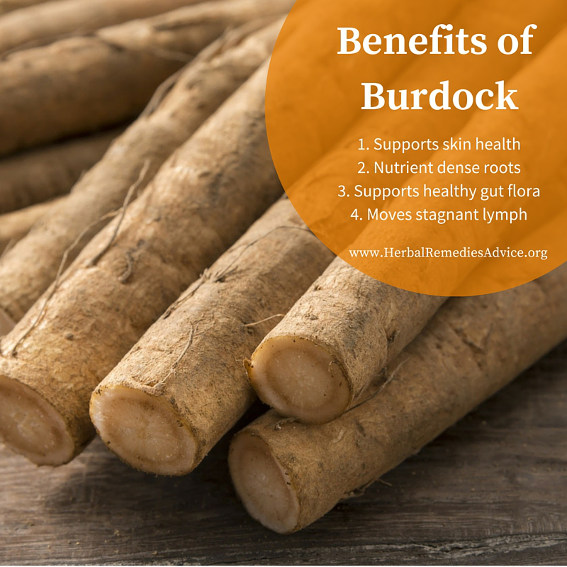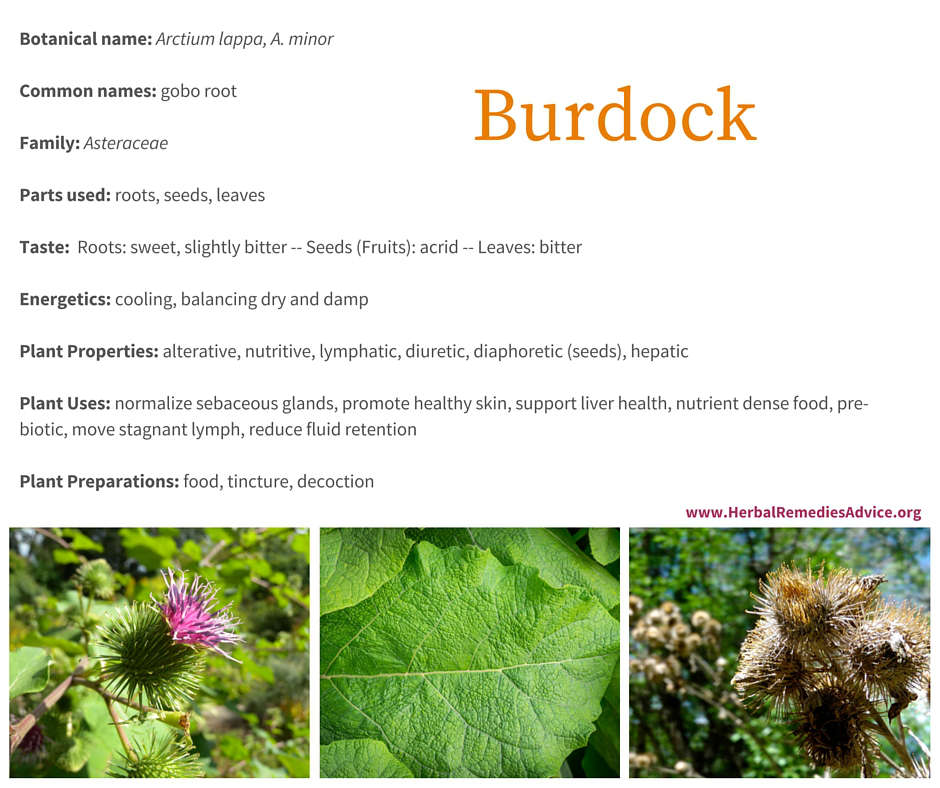Get weekly tips, recipes, and my Herbal Jumpstart e-course! Sign up for free today.

Burdock Benefits
Share this! |
|
Burdock is yet another example of a despised weed that gives us generous and powerful food and medicine. Its long taproot grows deep into the earth, pulling up nutrients to create medicine that herbalists use for chronic or deep illnesses. The burrs, which are a bane of ranchers, farmers, and animal owners, protect the powerful seeds that are strong-acting against acute infections.
This article will look at burdock benefits and the contemporary and historical uses of burdock root, seed, and leaf, as well as give a glimpse into the current scientific research in using burdock to protect the skin and to fight against cancer.
In the traditional herbalism of Europe and North America, burdock (Arctium lappa, A. minus) is probably the most prominent herb for skin complaints, such as acne, boils, or eczema. - Paul Bergner, Folk Remedies Database1
Burdock Benefits as an Alterative
Burdock is an archetypal alterative herb. To truly understand burdock benefits, we must begin with a firm grasp of the alterative action.
The concept of an alterative substance is specific to Western Herbalism. This concept certainly doesn’t exist in modern biomedicine. Chinese Medicine has herbs that “clear heat and remove toxins” and Ayurveda has herbs that may decrease Pitta but, while these concepts are similar, the alterative action still remains unique.
Alterative herbs were historically used to cleanse “bad blood.” Someone hearing this terminology today may incorrectly assume that it refers to a serious blood infection such as sepsis. But while some alterative herbs are used for infections, the term alterative is more encompassing than this. So a more general definition of alterative is something that “positively alters health in an unknown way” or “alters favorably the course of an ailment.” This definition is too vague to give us any real understanding of how to use these herbs.
Every herbalist seems to have their own idea of what alterative means; here’s mine:
Every day your body performs functions that produce metabolic wastes. (Sometimes these are called toxins, but I personally dislike this harsh term for something that is naturally occurring in the body.) Your body has numerous organs and functions that are specific for handling, processing, and eliminating this metabolic waste. The liver metabolizes hormones and processes nutrients from the portal vein, the lungs exhale CO2, the kidneys filter the blood and remove wastes through urine, macrophages engulf spent cells and remove them through the lymph, and on and on. These are all examples of detoxification and elimination.
When these systems of detoxification and elimination are working well, everything is running smoothly. Nutrients are coming in the body, various functions are breaking down those nutrients and delivering them throughout the body, and the body is naturally eliminating the “leftovers” or waste products. Visually I like to think of this as a clear running brook. Clean, free flowing water.
For a variety of reasons, elimination functions can slow down or become stagnant. Now, instead of that clear flowing brook, we have a stagnant pond. Metabolic wastes aren’t being removed and, instead, are building up in one or more areas of the body. This stagnant pond situation is what I think of as “bad blood”. Physiologically, it could involve the lymphatic system but in my own broad definition it could also include other examples of stagnancy in the colon, in the skin, etc. Specific examples of this may include lymphedema (lymphatic build up), hormone imbalance (possible liver stagnation resulting in complaints of hormonal excess), or gout (historically defined as being caused by “bad blood” or “rich food”).
Thus, alteratives are herbs that support detoxification organs and elimination functions. Metaphorically speaking, they come into a stagnant pond situation and break the dam to restore that clear flowing brook.
Various alterative herbs tend to have an affinity with different detoxification systems. Cleavers, poke and Stillingia work strongly on the lymph. Oregon grape root, dandelion root, and Chelidonium have an affinity for the liver. Dandelion leaves and nettle promote waste removal through the kidneys by diuresis.
Burdock root’s main affinity is with the skin and elimination through the skin. For hundreds of years, burdock benefits have been used for all sorts of rashes, from eczema to psoriasis, as well as acute skin infections such as acne and boils. Of course herbs rarely do just one thing. Burdock benefits also include noticeable effects on the urinary system and the liver. Because burdock affects multiple systems of elimination or detoxification, we can see why it is such an archetypical alterative herb.
For the successful treatment of chronic skin diseases, especially eczema, burdock has no equal, which for boils its quick alterative and curative effect is truly remarkable. - Edward Shook2
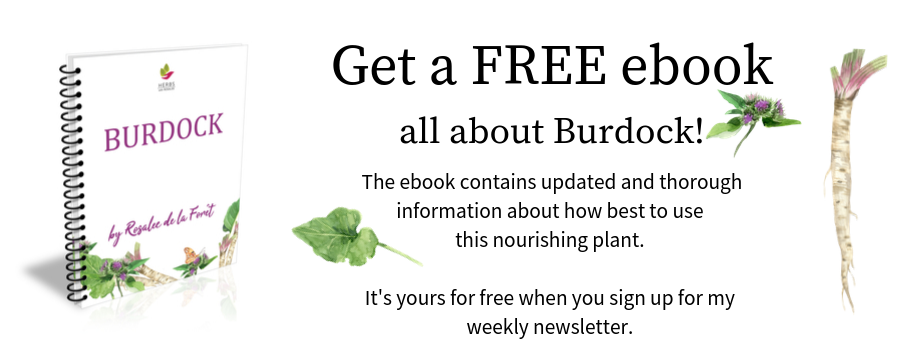
Energetics of Burdock Benefits
To further understand the nuances of burdock benefits, let’s look at its particular energetics.
The energetic profile of most alterative herbs is cooling and drying. While most herbalists agree that burdock benefits tend to be cooling, there is a complexity in its effect on internal moisture that is not easily summed up with a one-word classification such as damp or dry. On one hand, burdock root is a mild diuretic and the seed more so. Any time an herb promotes fluid loss, we designate it as drying. On the other hand, herbalists have been specifically using burdock for dry and scaly skin rashes for hundreds of years. Using a drying herb for a dry condition is outside of the box of western herbal theory, which typically uses opposite actions as treatment (e.g., a moistening herb for a dry condition).
How do we explain this discrepancy? Eclectic herbalists brilliantly deduced the physiological understanding of burdock benefits and it is again being made popular by herbalists like Matt Wood and jim mcdonald (and many more western herbalists who are energetically inclined).
The explanation is that burdock root and seed is specific to altering the health of the sebaceous glands, the small glands in the skin that secrete sebum, a lubricating oily substance. Sebum helps to lubricate the skin and hair and also has broad antimicrobial activity.
By positively affecting the sebaceous glands, burdock benefits have a very specific action with broad ranging results. When sebaceous glands aren’t working well, they can be either under-active or over-active, which can result in a variety of symptoms, including dry/scaly skin, different kinds of rashes, oily skin, or acne. Burdock can address a wide range of these types of skin conditions.
Matt Wood gives us his specific indications for burdock benefits:
I don’t have an easily taught specific indication for burdock root, but it is the first remedy to think of when there is a lack of oils or lipids in the body. Inability to digest, metabolize and use lipids. Dry skin, dry scalp and hair.
- Matthew Wood, American Herbalist Guild Symposium 2012 Proceedings 3
David Winston agrees with these energetic indications and also gives us insights into formulation:
The seed tincture is an excellent skin remedy indicated for dry, scaly, scratchy, or crusty skin conditions. It can be used with Milk Thistle seed and fish oil for the best results. - David Winston, American Herbalist Guild Symposium 2012 Proceedings 4
Herbalist jim mcdonald refers to burdock benefits as a sebaceous diaphoretic. He explains:
The body doesn’t only produce watery (sudoriferous) sweat, but also oily (sebaceous) sweat. I was first exposed to this point by the Physiomedicalist herbalist William Cook, who wrote: "Besides capillaries and sudoriferous glands, the skin contains a large number of sebaceous or oil glands. These give to the surface its natural softness and pliancy. They sometimes become quite deficient in action; and then the skin becomes harsh and chaffy, and no amount of watery sudoresis can restore its oily elasticity... A very small class of diaphoretics expend their main influence upon these sebaceous glands. The seeds of the Arctium lappa (Burdock) are among the best diffusives of this class; and the roots of Arctium and bark of Celastrus scandens (Bittersweet Vine) among the permanents.”
This was a very useful insight, but I didn’t really understand the role of oily sweat till talking about it with Matthew Wood. He explained that the body produced oily sweat as a defense against the cold and damp; when exposed to an extreme of these conditions, the body releases oily sweat to serve as an insulating barrier, as native Americans would use bear grease or some other fat to keep them warm in cold damp weather. 5
Burdock Benefits for the Urinary System
Historical texts emphasize the importance of burdock benefits as both diuretic and diaphoretic. While both the root and seed of burdock are said to be diuretic, the seed is considered to have a stronger effect. (Although, having drunk a decoction made from 15 grams of burdock root for the past several days, I can’t say I’ve noticed a diuretic effect at all.) The seed also is considered to be diaphoretic while the root is not.
The Western Herbal Tradition (by Alison Denham, Graeme Tobyn, and Margaret Whitelegg) lists many specific uses for burdock benefits in the urinary system, including as “a diuretic and anti-lithic for cystitis, urinary gravel and stones and resulting oliguria, and functional problems of urination such as enuresis.”6
King’s American Dispensatory specifically lists burdock seed as a diuretic alterative. It says:
They form a good diuretic alterative, and are used in diseases of the kidneys, and to remove boils and sties on the eyelids. The action of the seeds upon the urinary tract is direct, relieving irritation and increasing renal activity, assisting at the same time in eliminating morbid products. In chronic disorders, lappa [burdock] may be used to remove worn-out tissues, where the saline diuretics are inadmissible. Dropsy and painful urination, due to renal obstruction, have been relieved by it. A tincture of the fresh fruit or specific lappa should be employed. 7
Burdock Benefits as a Prebiotic
Burdock root is high in inulin with many sources citing a total of 45-50% in the fresh root. Inulin (not to be confused with insulin) is a starchy carbohydrate that is indigestible to humans but provides nutrients for the gut flora. Consuming prebiotic foods along with fermented foods or probiotic capsules is believed to more effectively support a diverse microbiome.
Some people may find that eating large amounts of foods high in inulin, including burdock root, dandelion root, and Jerusalem artichoke, may induce what western herbalists politely refer to as “wind”. In other words, for those sensitive to inulin’s effects, I wouldn’t recommend eating lots of burdock root on a first date.
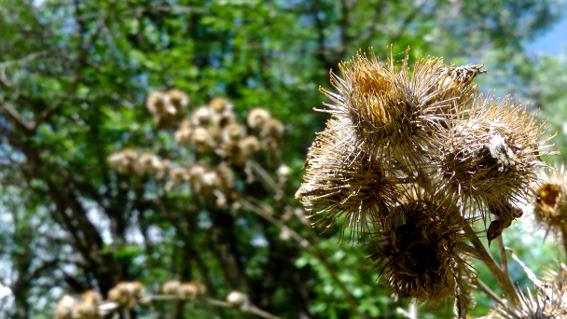 Burdock Seeds
Burdock SeedsBurdock Benefits: The Seeds
It is generally agreed upon that burdock seeds are stronger in action than the root. A more nuanced view may be that the seed is more beneficial in acute stages of an illness while the root is better for chronic issues. Herbalist jim mcdonald explains this as the seed having more diffusive qualities while the root is more permanent in action.
Eclectic herbalists seemed to have used the seeds more than the root. It’s possible the seeds fell out of favor because they are notoriously difficult to harvest, as the burs are prickly and the seeds are surrounded by irritating hairs. The easy way to separate the seeds is to close the burs up in a strong paper bag and to pummel them with a hammer.
In Chinese Medicine, burdock seeds are used more commonly than the root. Jeremy Ross writes that the seeds are specifically used to “clear Wind Heat for a sore, red, swollen throat with fever and cough, for red swellings such as boils, and it moistens the intestines for constipation with internal heat or toxin with sore throat, rashes or acne.” 8
Burdock Benefits: The Leaves
Burdock leaves are mostly used externally as fresh poultices, especially for burns. The large leaves were historically used to wrap and preserve butter.
Herbalist Jeremy Ross writes, “Dioscorides recommended Arctium leaves as a poultice to heal old ulcers, and Lonicerus wrote that the green leaves can be used to clear heat, and that burdock can be used to ‘heal wounds with a lot of pus and rotten flesh,’ and ‘to soften hard swellings and to pull out evil substances with pus.’”9
Henriette Kress uses the leaves internally: “I’ve given the leaf as a nice diuretic appetite-enhancing liver herb. Bitter, bitter, bitter, but actually ingestible if you add a splash of vinegar or lemon juice to your burdock leaf tea.”10
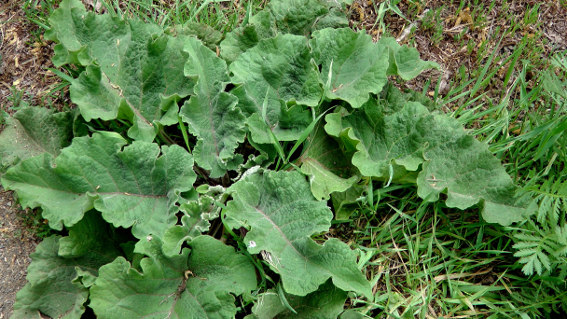 Burdock Leaves
Burdock LeavesHistorical Use of Burdock
Many sources recommend using burdock for a variety of venereal diseases, mainly syphilis. There also are many references for using burdock benefits for a prolapsed uterus, going back as far as Culpepper. Matthew Wood presents a modern day case study of successfully helping a woman with a prolapsed uterus in The Book of Herbal Wisdom.11
Burdock has been famously used for people with cancer for at least a hundred years. It was a main herb in the two famous cancer formulas from the 1920s: Essiac and the Hoxsey formula.
Scientific Studies on Burdock Benefits
Various individual constituents of burdock have been tested in vitro with promising results. To date, however, there are no human clinical trials using burdock.
There are a number of studies looking at constituents of burdock having an anti-cancer effect. One constituent, the lignan arctigenin, has been shown to induce apoptosis (cell death) in ovarian cancer cells and estrogen receptor-negative breast cancer.12,13 Arctigenin and other lignans have also been shown to have positive effects against multidrug-resistant cancer cells.14
Isolated constituents of burdock have also been shown to have a positive effect on skin cells in vitro. One study showed that arctiin induces a UVB-protective effect in human dermal fibroblast cells.15 Another study looked at the effect of pure arctiin in vitro and an extract of burdock seed/fruit extract in vivo. They concluded that: “Our data show that topical treatment with a natural A. lappa fruit extract significantly improves the metabolism of the dermal extracellular matrix and leads to a visible wrinkle reduction in vivo. In conclusion, A. lappa fruit extract represents a targeted means to regenerate dermal structures and, thus, offers an effective treatment option for mature skin.”16
Dandelion root and burdock root are my two most commonly prescribed herbs when chronic conditions require anti-inflammatory, blood purifying alteratives for gentle detoxification. This includes conditions such as arthritis and cancer. - Michael Tierra 17
Burdock Uses
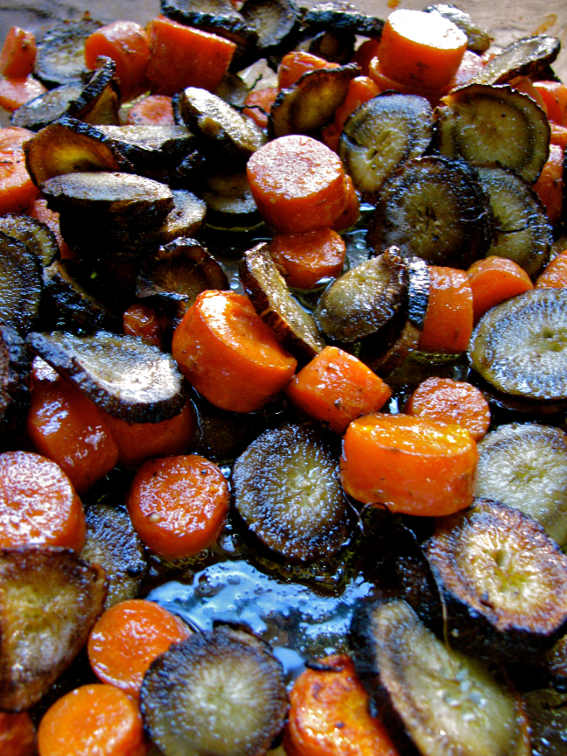 Roasted Carrots and Burdock Root
Roasted Carrots and Burdock RootWhile burdock root is used as medicine by herbalists, it is assuredly food as well. If you want to avoid the back-breaking, calorie-burning experience of harvesting the wild root, you can often find it being sold as “gobo” in Asian grocery stores or health food stores. My local health food store orders it on my request. The fresh root works well in stir-fries, soups or even roasted with other veggies. It can be preserved as a ferment or it can be preserved in a vinegar and tamari sauce. A handful of chopped fresh or dry burdock root cooked with rice is one easy way to incorporate it into your diet. The leaf stems of the first-year plant can be peeled and eaten fresh or cooked.
Herbalists rarely agree on anything, but most will say that the health benefits of burdock root are best experienced when taking it long term.
Dosage:
- As a food: Have at it (although some may find it creates a lot of gas).
- Root as a decoction: 15-30 grams
- Seeds: 3-10 grams (Winston)18
- Tincture (seed): 2-3 ml three time per day (Winston)19
Explore more burdock uses in Sue Kusch's article, which includes a Root Beer Bitters Recipe!
Burdock Side Effects
- Burdock root is a common vegetable and is considered to be safe for most people.
- As with many alteratives, people with skin conditions may see an increase in symptoms when they first start to take burdock. To decrease this effect, try combining it with more eliminating herbs as well as starting with a lower dose and slowly increasing the dosage.
- There have been a few reports of adverse effects of burdock in people allergic to Asteraceae family plants.
- Safety of the seed has not been conclusively established in pregnancy and lactation.
Botanically Speaking
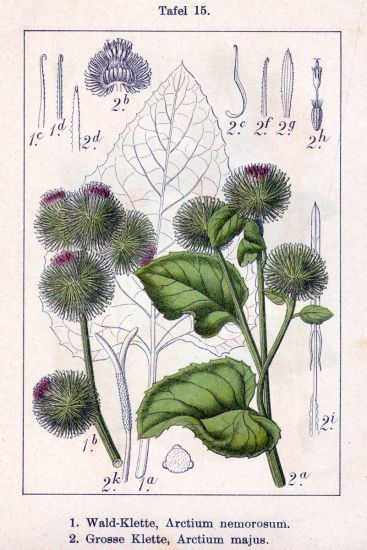 The Botany of Burdock
The Botany of BurdockBurdock has spread to many parts of the Northern Hemisphere. It grows in full or partial sun in a variety of soil conditions.
It is a biennial plant, meaning that it completes its life cycle in two years.
In the first year’s growth, it develops large simple basal leaves that grow near to the ground. It produces a long taproot that is pithy white in the center and covered in a thin brown skin. Burdock root is best harvested in the fall of the first year of growth. Because burdock likes to grow in compact soils and the roots go deep into the earth, harvesting the wild root can be quite challenging.
In the second year, it forms a central flower stalk that can grow from 3 to 6 feet tall. The flower is a purple thistle-like flower that then develops into a structure containing small hard fruits commonly, but technically incorrectly, called seeds. After the fruits are developed, the individual plant dies. No need to grab your tissues, however, as it has assuredly done a good job of reproducing for the next generation. Those dried burrs quickly grab onto anything they come in contact with, whether it’s animal fur or your favorite jacket. They burrow in and hitch a ride to spread their seeds far and wide. Burdock burrs may have been the inspiration for Velcro®.
Burdock will grow in pretty much any type of soil. One year, my husband was tanning sheep hides that were harboring burdock burrs. He excavated the burrs from the skins and tossed them into our super dense, rock hard, gravely driveway where virtually no plant grows. I say virtually because, as you might have guessed, we now have burdock gracing our otherwise barren driveway.
Summary of Burdock Benefits
Burdock is a favorite alterative that is especially used by herbalists for restoring healthy skin. The root provides deep nourishment and is best used long term for chronic illnesses. The seeds offer faster-acting results that are often used for more acute symptoms, such as red swollen throats or urinary problems. The large leaves of burdock can be used externally as poultices for burns or rheumatism. While there are many important uses for burdock, it’s rarely “convenient” medicine. The roots can be difficult to dig and the fruits can be challenging to separate from their burrs. Even still, burdock remains a popular herb for healthy skin secretions, as a diuretic, and also for cancer support.
Citations for Burdock Benefits
Click to show/hide.
Rosalee is an herbalist and author of the bestselling book Alchemy of Herbs: Transform Everyday Ingredients Into Foods & Remedies That Healand co-author of the bestselling book Wild Remedies: How to Forage Healing Foods and Craft Your Own Herbal Medicine. She's a registered herbalist with the American Herbalist Guild and has taught thousands of students through her online courses. Read about how Rosalee went from having a terminal illness to being a bestselling author in her full story here.
